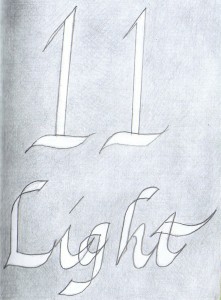“The universe is based on the fundamental reality that all things are related and within that underlying notion of unity, all things are energy.”
from The Complete Idiot’s Guide to Numerology
11/2: Spiritual Messenger
Numerologists write the Master Number 11 as 11/2. Colors associated with the Master Number 11 are white and silver.
11/2s seek self-illumination through spiritual inspiration and seek to inspire others to do the same. They are natural-born leaders, charismatic, creative, intuitive, inspirational, and visionary.
11/2s have double the attributions of the 1: independence, innovation, determination, courage and the ability to lead. They also share the traits of the 2: sensitivity, coöperation, patience, and team spirit.
Wolfgang Amadeus Mozart (composer 1756 – 1791), Prince Charles (British Royal Family 1948 – the present), Antonio Vivaldi (composer 1678 – 1741), and President William J. Clinton (42nd President of the U.S. 1947 – the present), among others, have an 11/2 Life Path. They are dissimilar personalities with different career paths, but they share common attributes including the ability to lead and inspire others and to achieve fame.
(For a guide to determining your life path number, see The Idiot’s Guide to Numerology by Kay Lagerquist and Lisa Lenard. It’s easy!)
11/2s are true visionaries who serve others by serving in their own field of work.
Bibliography:
Lagerquist, Kay. The Complete Idiot’s Guide to Numerology. Indianapolis, IN: Alpha Books, 1999.
Hay, Louise L. Colors and Numbers, Your Personal Guide to Positive Vibrations in Daily Life. Carlsbad, CA: Hay House, 2010.
Millman, Don. The Life You Were Born to Live. Tiburon, CA: H. J. Kramer/New World Library, 1993.
Vogel, Christopher. The Writer’s Journey; Mythic Structures for Story tellers and Screenwriters. Studio City, CA: M. Wiese Productions 1998.
Pythagoras and Numerology
Numerology is the study of the meanings of names and numbers and their relationship to each other and has its roots in the cultures of ancient Greece, China, Rome and Egypt and the Hebrew Kabbalah.
Pythagoras was a Greek mathematician and mystic from the 6th century B.C.E. He is one of the fathers of numerology and regarded as the father of geometry.
He based his system of names and numbers on his belief that numerical relationships permeate nature. Numbers are a source of form and energy and numbers 1 through 9 represent the nine stages of the cycle of life.
Pythagoras and his followers believed that divine law could be calculated through mathematics.
Pythagoras, however, associated numbers with many ideas not just divine law. For example, he explored musical harmony through mathematics and called his concept “The Music of the Spheres.” Pythagoras believed that everything vibrates to its own special harmony; the higher the vibration, the more (or positive) force it has but the lower the rate of vibration, the less (or negative) force it has.
The Sketchbook Project “is the world’s largest library of artists’ books…”
The sketchbooks also travel North America and even the world via the Mobile Library. For more information, go to https://www.sketchbookproject.com.
I participated in the Sketchbook Project in 2012 and 2013. It’s time to take part again.
This year’s theme is Numerology and the visual power of numbers and letters and their relationship to each other.




